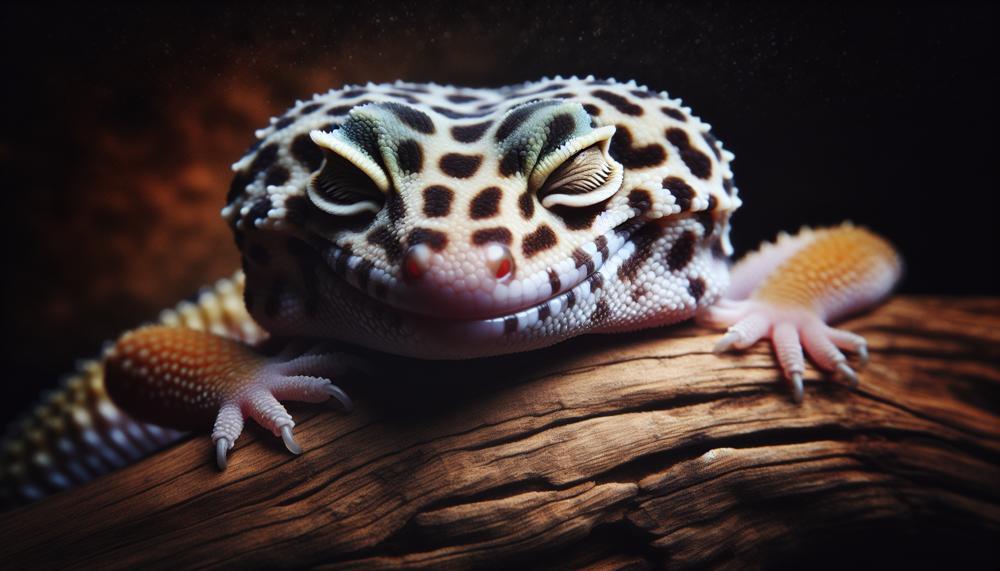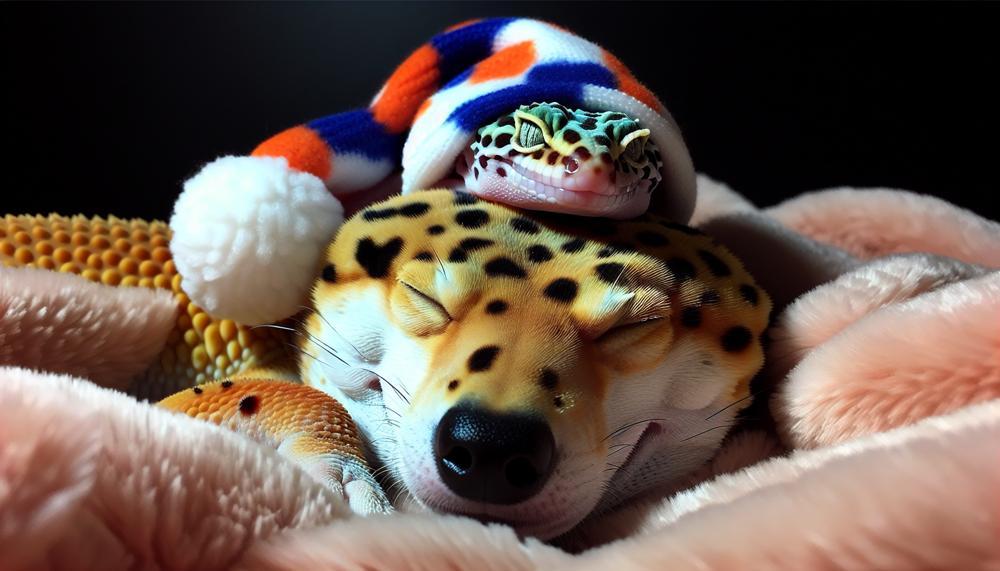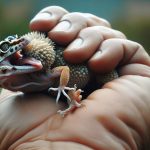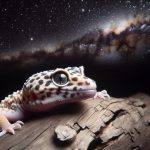Have you ever wondered how leopard geckos catch their Z’s? These captivating creatures have a unique set of sleep patterns. They are sure to pique your interest.
As a reptile enthusiast, I’ve spent countless hours observing these nocturnal creatures. I’ve also uncovered the secrets of their slumber.
In this blog post, I’ll be sharing everything you need to know about leopard gecko sleep habits.
We’ll cover their preferred sleeping spots and quirky behaviors.
- Leopard geckos are crepuscular animals, meaning they’re most active during dawn and dusk.
- They have a special adaptation called “eyelid licking.” It helps them clean and moisturize while they snooze.
- Unlike other lizards, leopard geckos don’t hibernate during the colder months.
- Their sleeping positions can range from stretched out to curled up in a ball.
- Proper lighting and temperature play a crucial role in their slumber.
So, grab your favorite cup of tea and get ready to explore the fascinating world of leopard gecko sleep.
Contents
Understanding Leopard Gecko’s Sleep Cycle
The sleep cycle of a leopard gecko stands out from that of most other animals in several ways. Many animals, including humans, follow a diurnal or nocturnal sleep pattern. Leopard geckos display both nocturnal and crepuscular behaviors. Their natural habitat has shaped them to avoid extreme daytime temperatures. This is why they also evade predatory birds.
Leopard geckos need a temperature gradient in their enclosure to sleep and thrive. This is another notable difference. This means that one side of their habitat should be warmer, while the other side should be cooler. This allows them to regulate their body temperature. They move to different areas as needed.
Leopard geckos also have specific light requirements for their natural sleep cycle. They need a balance of 12 hours of light and 12 hours of darkness to support their overall health and behavior. However, other animals may have different light needs or sleep patterns.
Moreover, leopard geckos possess unique adaptations that aid them in their nighttime activities. For instance, their vertical pupils and skin coloration enable them to see in low light conditions. They also help the predators blend in with their surroundings while hunting for food.
How long do leopard geckos sleep?
Leopard geckos sleep for about 12 hours on average per day. However, they are most active and awake throughout the night.

Leopard geckos are crepuscular, meaning they are active from dusk to dawn. During the day, you can find them napping around their enclosure.
Leopard geckos are mostly nocturnal but technically diurnal, so they sleep most of the day. They sleep curled up in their shelters whether dry or humid, but they sometimes randomly lie around their enclosures.
Leopard geckos are one of only a few geckos that have eyelids, allowing them to close their eyes when they sleep.
Factors Influencing Leopard Gecko’s Sleep Pattern
External factors, particularly temperature and lighting, heavily influence the sleep pattern of leopard geckos. These elements are crucial for maintaining the geckos’ natural sleep cycle. They also promote their overall health and wellness.
As pet owners, it is our responsibility to provide them with a suitable environment that supports their sleep needs.
Temperature:
Leopard geckos are ectothermic. They rely on external sources to regulate their body temperature. This makes it essential to create a suitable temperature gradient in their enclosure.
According to research, the ideal basking temperature for leopard geckos is 88-92°F. A warm hide should be 87-90°F and a cooler end 70-78°F. The geckos must maintain these temperatures to thermoregulate and enter deep sleep.
Lighting:
Leopard geckos are primarily nocturnal creatures. It’s necessary to provide them with a proper light and dark cycle. This maintains their natural sleep pattern. It is recommended to provide approximately 12 hours of light and 12 hours of darkness in their habitat to support their circadian rhythm.
Excessive light exposure can disrupt their sleep patterns. This can lead to sleep deprivation and possible health issues.
Hiding Spots:
Given that leopard geckos are naturally shy and reclusive animals, it is crucial to provide them with hiding spots in their enclosure.
Rocky caves or tunnels make excellent hiding spots. They allow animals to retreat and rest undisturbed. This provides a sense of safety and security while sleeping.
Social Interactions:
In the wild, leopard geckos are social animals and often live in groups. Social interactions with other geckos can significantly impact their sleep patterns. If kept alone, they may experience stress and have difficulty sleeping.
Therefore, it is vital to provide them with adequate social interactions. This promotes healthy sleep patterns.
Comparison to Other Geckos
Leopard geckos have distinct sleeping habits that set them apart from other gecko species. These differences can be attributed to their natural habitat, dietary preferences, and innate behaviors.
- Ground-Dwelling Sleepers: Unlike their tree-dwelling counterparts, leopard geckos prefer to sleep on the ground. This is due to their natural inclination as ground-dwelling creatures, making them feel more secure and safe when sleeping close to the ground.
- Nocturnal Sleep Patterns: As nocturnal animals, leopard geckos are most active at night and sleep during the day. This is in contrast to diurnal geckos that are active during the day and rest at night.
- Hiding Spots: In their natural habitat, leopard geckos seek out hiding spots to rest and sleep during the day. This behavior also carries over in captivity, where providing hiding spots is crucial for their well-being. These hiding spots provide a sense of security and comfort for leopard geckos to sleep peacefully.
- Temperature-Sensitive: Leopard geckos are sensitive to temperature changes, which can impact their sleep patterns. Maintaining a consistent temperature in their habitat is essential to ensure they can rest comfortably.
- Diet: Unlike other gecko species, leopard geckos have a unique diet that can also affect their sleeping behavior. As insectivores, they primarily feed on live insects, which they hunt at night. This makes them most active at night when food is readily available.
Impacts of Disturbed Sleep in Leopard Geckos
Leopard geckos may seem like low-maintenance pets, but their sleep is essential for their overall health and well-being.
When these nocturnal creatures are unable to get the rest they need, it can significantly impact their physical and behavioral health.
The Effects on Health:
Disturbed sleep in leopard geckos can have severe consequences on their physical health. These creatures require a quiet and dark environment to get proper rest. Disrupted sleep can lead to stress. This weakens the immune system and makes people more susceptible to illness.
Moreover, leopard geckos are highly sensitive to temperature. They need a specific range to maintain their health. Disrupted sleep can cause fluctuations in their body temperature. This can result in digestive problems, respiratory infections, and metabolic bone disease.
The Effects on Behavior:
Disturbed sleep affects the physical health of leopard geckos. It also significantly impacts their behavior. These docile creatures can become agitated and aggressive when they experience disrupted sleep. They may spend more time hiding than usual. This is because they feel stressed and anxious.
Disturbed sleep can also disrupt their appetite and shedding process. A lack of sleep can cause a decrease in appetite, leading to weight loss and malnutrition. It can also interfere with the shedding process. This interference can result in incomplete or delayed shedding.
Tips for Providing Quality Sleep:
- Create a quiet and dark sleeping environment for your leopard gecko.
- Keep the temperature within the recommended range.
- Reduce stress by providing adequate hiding spots and minimizing disturbances.
- Monitor your gecko’s behavior and consult a veterinarian if you notice any concerning changes.
Ways to Monitor Sleeping Patterns of Leopard Geckos
Leopard geckos are fascinating creatures, and as owners, we want to provide the best care for them. One essential aspect of their well-being is understanding their sleep patterns.
We can gain valuable insights into their rest and activity levels by using various methods. This allows us to make necessary adjustments for their health.
- Observation: The simplest way to track leopard geckos’ sleeping patterns is through regular observation. This involves monitoring their hiding spots and basking areas during the day and night. Keeping a record of their activities helps determine the average time they spend sleeping.
- Video Monitoring: Setting up a camera in their enclosure allows for continuous monitoring of leopard geckos’ sleep patterns. This method is especially useful for observing their crepuscular behaviors at dawn and dusk, as well as any nighttime activities.
- Temperature Sensors: Temperature plays a crucial role in leopard geckos’ sleep, and using temperature sensors can provide valuable information about their sleeping patterns. These sensors track temperature changes throughout the day and night, helping us create an ideal sleeping environment for our pets.
- Activity Trackers: Similar to fitness trackers for humans, activity trackers designed for reptiles can monitor leopard geckos’ movements throughout the day and night. By analyzing the collected data, we can determine how long they are awake and asleep.
- Sleep Study Devices: Advanced technology devices like sleep study devices can track leopard geckos’ brainwaves and body movements during sleep. This method provides accurate data on their sleep cycles and duration.
These methods provide insights into leopard geckos’ natural sleep patterns. They help us understand how long they sleep.
Conclusion
In conclusion, the slumber habits of leopard geckos are complex and intriguing. This is an aspect of their behavior.
Factors like their natural habitat, temperature, and lighting influence the creatures’ unique sleep patterns. Responsible pet owners must carefully consider this. Providing a suitable sleeping environment is crucial for their well-being. It also helps prevent potential health issues.
Leopard geckos are fascinating. They sleep in a crepuscular way and have special adaptations for survival. This makes them worthy of further exploration.






